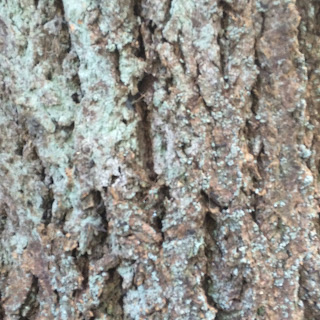The very first organism we found was the lichen, which was actually composed of two organisms, fungi and and algae cells. It was really cool since I saw this everywhere, but never knew it was fungi! Here is a picture of it on a tree:
The lichen is the blueish-green organisms on the tree bark, and the fungi and algae that compose it have a mutualistic relationship where the algae photosynthesize sugars, and the fungi collects nutrients. Korena pointed out that on that tree, there were actually two different lichen types: the crusty ones on the right of the picture that look like dots, and the powdery ones on the left of the picture, which was really interesting to see in person! We continued our walk in the park and found more fungi called conks, and we found one growing on a dead log, so we got to see the decomposers in action! Here is a couple pictures of them:
 |
| The fruiting bodies of the conks on the side of the log |
As seen in the picture above, the fruiting bodies were already growing on the side of the log, and their mycelium were probably already growing inside the dead log, too. The white smear on the upper right of the picture was also part of the conk.
As we continued our walk, Korena gave us some interesting fungi facts as well. She explained that the mycelium of fungi can span across entire forests, from one side to the other, which was just amazing to me. She also mentioned that they can signal each other when danger is present on one side of the forest, like a poison spill, so that the fungi on the other side of the forest can prepare for it! She also mentioned that the a fungi in Oregon is considered to be the 'largest' organism in the world by area!
We eventually stumbled upon the type of fungi where the fruiting body looked familiar to me. The first one was a basidiomycete by the look of its cap, and it's fruiting body looked like pancakes growing on the side of a dead log, which made me to presume that they are shelf fungi. Here is a picture of it:
We also found another basidiomycete, but it's fruiting body was growing in the soil this time. Here is a picture of it:
I could clearly see the gills, which were really smooth and fragile. The ring was still there, which was from when the cap of the mushroom opened up. Korena also mentioned that this particular mushroom was of the genus Amanita, the same genus of the death cap mushroom, the deadliest mushroom in the world, which was cool and slightly frightening at the same time!
In the end, this field trip was a a good and fun way to observe fungi in the wild instead of doing so under a microscope in lab, and it was cool to see them in their natural habitat! I really appreciated this field trip and I would definitely be willing to do it again!



No comments:
Post a Comment